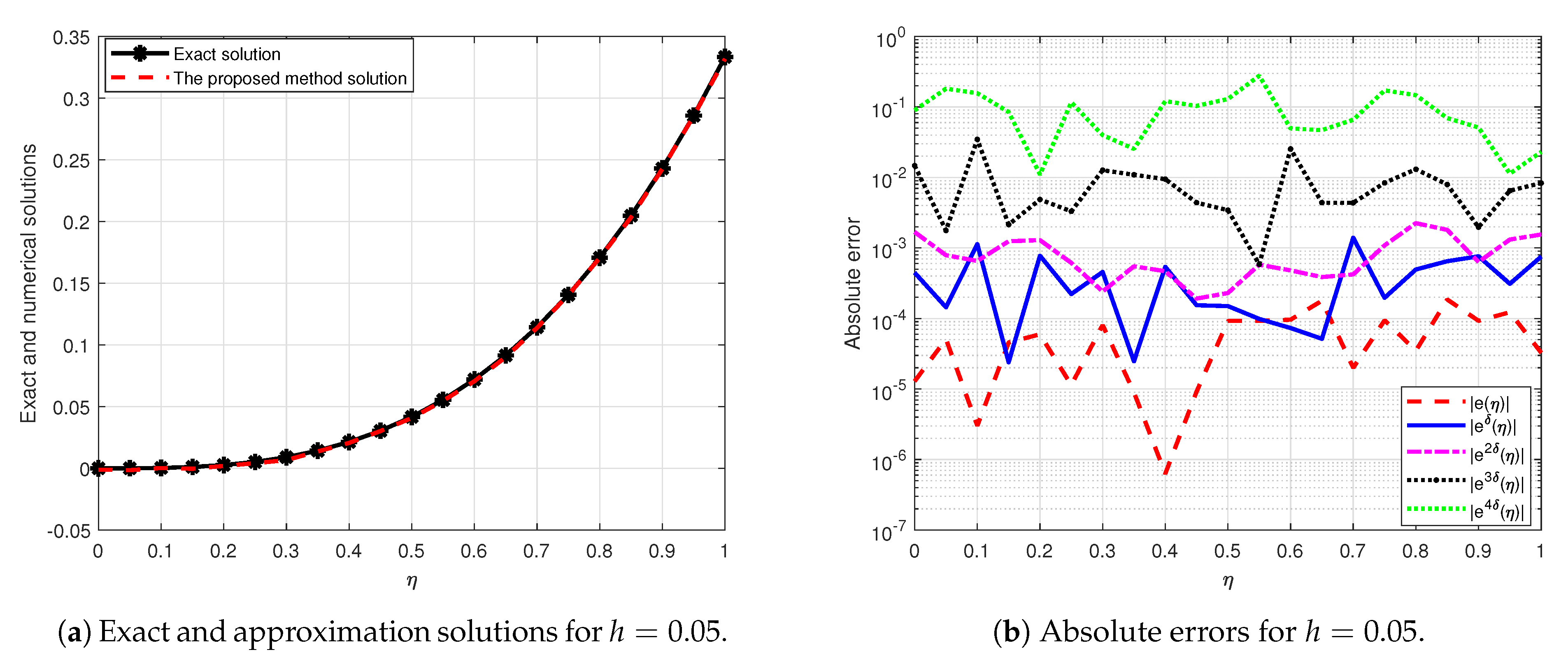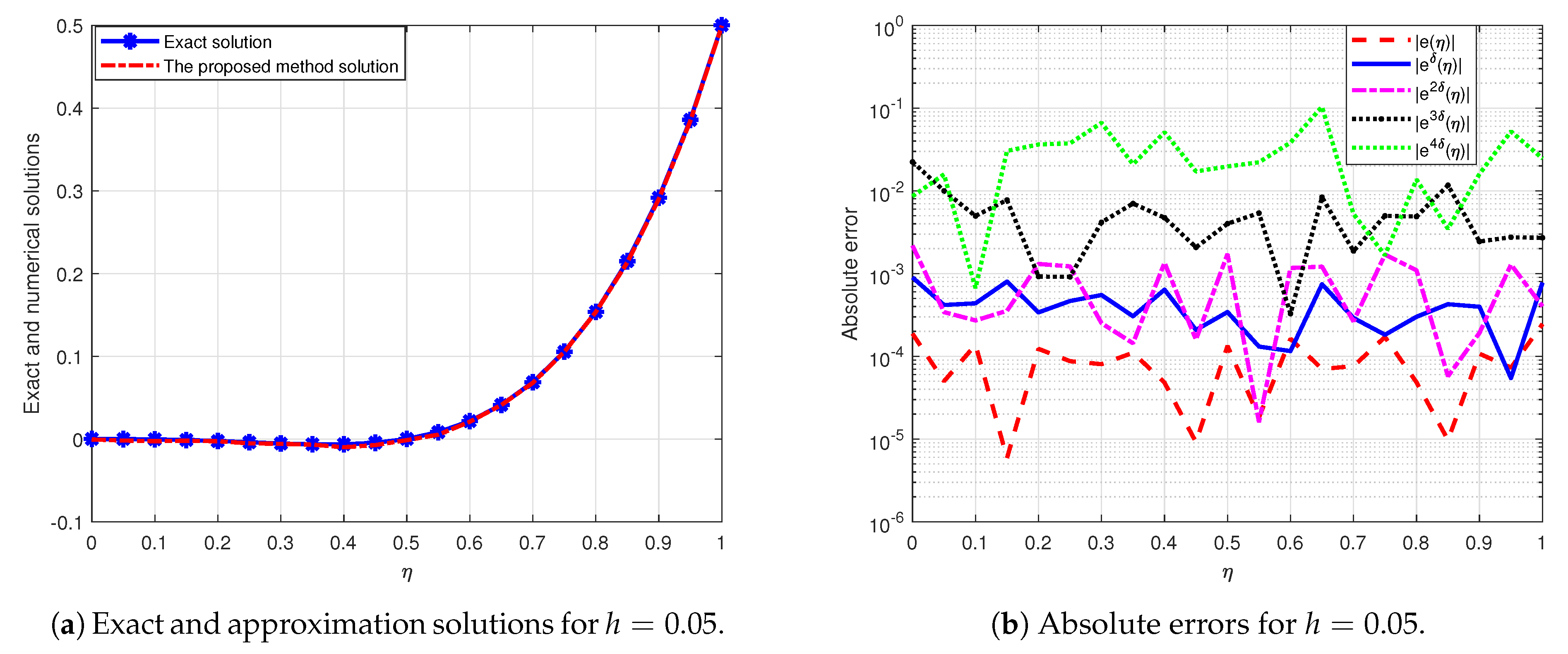Some Higher-Degree Lacunary Fractional Splines in the Approximation of Fractional Differential Equations
Abstract
1. Introduction
2. Definitions and Preliminaries
2.1. Fractional Calculus
- (1)
- and for all .
- (2)
- is continuous on .
2.2. Formulation of the Problem
3. The First Class of Lacunary Fractional Spline
3.1. Existence and Uniqueness
3.2. Error Bounds
4. The Second Class of Lacunary Fractional Spline
5. Applications
6. Conclusions
- Two classes of higher-order lacunary fractional spline functions are introduced.
- A new lacunary fractional spline method is obtained for the above-mentioned classes by using the Liouville–Caputo fractional Taylor expansion.
- The existence and uniqueness of the method on each of the classes is proved.
- The error bounds of the method is shown via the modulus of continuity.
- Some Liouville–Caputo FDEs are solved by using the new method in order to illustrate our theoretical results.
- The numerical solutions are also illustrated graphically.
Author Contributions
Funding
Institutional Review Board Statement
Informed Consent Statement
Data Availability Statement
Acknowledgments
Conflicts of Interest
References
- Mainardi, F. Fractional Calculus and Waves in Linear Viscoelasticity: An Introduction to Mathematical Models; Imperial College Press: Singapore, 2010. [Google Scholar]
- Magin, R.L. Fractional Calculus in Bioengineering; Begell House Publishers Incorporated: Danbury, CT, USA, 2006. [Google Scholar]
- Mohammed, P.O. A Generalized Uncertain Fractional Forward Difference Equations of Riemann–Liouville Type. J. Math. Res. 2019, 11, 43–50. [Google Scholar] [CrossRef]
- Mohammed, P.O.; Abdeljawad, T. Discrete generalized fractional operators defined using h-discrete Mittag-Leffler kernels and applications to AB fractional difference systems. Math. Meth. Appl. Sci. 2020, 1–26. [Google Scholar] [CrossRef]
- Mohammed, P.O.; Abdeljawad, T.; Jarad, F.; Chu, Y.-M. Existence and uniqueness of uncertain fractional backward difference equations of Riemann–Liouville type. Math. Prob. Eng. 2020, 2020, 6598682. [Google Scholar] [CrossRef]
- Alqudah, M.A.; Mohammed, P.O.; Abdeljawad, T. Solution of singular integral equations via Riemann–Liouville fractional integrals. Math. Prob. Eng. 2020, 2020, 1250970. [Google Scholar] [CrossRef]
- Martinez, M.; Mohammed, P.O.; Valdes, J.E.N. Non-conformable fractional Laplace transform. Kragujevac J. Math. 2020, 46, 341–354. [Google Scholar]
- Hamasalh, F.K.; Mohammed, P.O. Generalized quartic fractional spline interpolation with applications. Internat. J. Open Probl. Compt. Math. 2015, 8, 67–80. [Google Scholar] [CrossRef]
- Tassaddiq1, A.; Yaseen, M.; Yousaf, A.; Srivastava, R. A cubic B-spline collocation method with new approximation for the numerical treatment of the heat equation with classical and non-classical boundary conditions. Phys. Scr. 2021, 96, 045212. [Google Scholar] [CrossRef]
- Khabir, M.H.; Farah, R.A. 2017 Cubic B-spline collocation method for one-dimensional heat equation. Pure Appl. Math. 2017, 6, 51–58. [Google Scholar] [CrossRef]
- Kilbas, A.A.; Srivastava, H.M.; Trujillo, J.J. Theory and Applications of Fractional Differential Equations; North-Holland Mathematics Studies; Elsevier Sci. B.V.: Amsterdam, The Netherlands, 2006; Volume 204. [Google Scholar]
- Hilfer, R. Applications of Fractional Calculus in Physics; World Scientific Publishing Company: Singapore, 2000. [Google Scholar]
- Podlubny, I. Fractional Differential Equations: An Introduction to Fractional Derivatives, Fractional Differential Equations, to Methods of Their Solution and Some of Their Applications; Mathematics in Science and Engineering; Academic Press: New York, NY, USA, 1999; Volume 198. [Google Scholar]
- Srivastava, H.M. Fractional-order derivatives and integrals: Introductory overview and recent developments. Kyungpook Math. J. 2020, 60, 73–116. [Google Scholar]
- Usero, D. Fractional Taylor Series for Caputo Fractional Derivatives: Construction of Numerical Schemes. Preprint 2008. Available online: http://www.fdi.ucm.es/profesor/lvazquez/calcfrac/docs/paper_Usero.pdf (accessed on 2 March 2018).
- Fernandez, A.; Baleanu, D. The mean value theorem and Taylor’s theorem for fractional derivatives with Mittag–Leffler kernel. Adv. Differ. Equ. 2018, 2018, 86. [Google Scholar] [CrossRef] [PubMed]
- Steffens, K.G. The History of Approximation Theory; Birkhäuser: Basel, Switzerland, 2006. [Google Scholar]
- Srivastava, H.M. Diabetes and its resulting complications: Mathematical modeling via fractional calculus. Public Health Open Access 2020, 4, 1–5. [Google Scholar]
- Srivastava, H.M.; Deniz, D.; Saad, K.M. An efficient semi-analytical method for solving the generalized regularized long wave equations with a new fractional derivative operator. J. King Saud Univ. Sci. 2021, 33, 101345. [Google Scholar] [CrossRef]
- Singh, H.; Srivastava, H.M.; Hammouch, Z.; Nisar, K.S. Numerical simulation and stability analysis for the fractional-order dynamics of COVID-19. Results Phys. 2021, 20, 103722. [Google Scholar] [CrossRef] [PubMed]
- Srivastava, H.M.; Mohammed, P.O. A correlation between solutions of uncertain fractional forward difference equations and their paths. Front. Phys. 2020, 8, 280. [Google Scholar] [CrossRef]


| Methods | h | |||||
|---|---|---|---|---|---|---|
| Our method | ||||||
| Method in [8] | ||||||
| Methods | h | |||||
|---|---|---|---|---|---|---|
| Our method | ||||||
| Method in [8] | ||||||
Publisher’s Note: MDPI stays neutral with regard to jurisdictional claims in published maps and institutional affiliations. |
© 2021 by the authors. Licensee MDPI, Basel, Switzerland. This article is an open access article distributed under the terms and conditions of the Creative Commons Attribution (CC BY) license (http://creativecommons.org/licenses/by/4.0/).
Share and Cite
Srivastava, H.M.; Mohammed, P.O.; Guirao, J.L.G.; Hamed, Y.S. Some Higher-Degree Lacunary Fractional Splines in the Approximation of Fractional Differential Equations. Symmetry 2021, 13, 422. https://doi.org/10.3390/sym13030422
Srivastava HM, Mohammed PO, Guirao JLG, Hamed YS. Some Higher-Degree Lacunary Fractional Splines in the Approximation of Fractional Differential Equations. Symmetry. 2021; 13(3):422. https://doi.org/10.3390/sym13030422
Chicago/Turabian StyleSrivastava, Hari Mohan, Pshtiwan Othman Mohammed, Juan L. G. Guirao, and Y. S. Hamed. 2021. "Some Higher-Degree Lacunary Fractional Splines in the Approximation of Fractional Differential Equations" Symmetry 13, no. 3: 422. https://doi.org/10.3390/sym13030422
APA StyleSrivastava, H. M., Mohammed, P. O., Guirao, J. L. G., & Hamed, Y. S. (2021). Some Higher-Degree Lacunary Fractional Splines in the Approximation of Fractional Differential Equations. Symmetry, 13(3), 422. https://doi.org/10.3390/sym13030422









